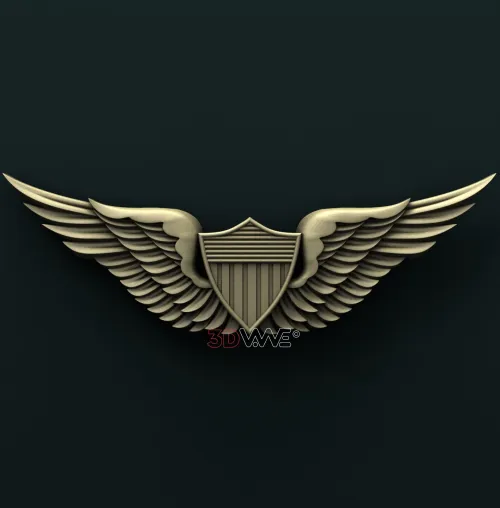Army Aviator Insignia Carving-All American Woodworks
This Army Master Aviator wall plaque is hand painted and constructed of solid mahogany. It's a great addition to any military collection. It has a recessed hook at the back, so it will hang flush against any wall. If you're looking to hang it on a table or wall it will be a great addition to any space. Army Aviator Wall Plaque is sure to be a fantastic addition to your office or home.
Aircraft Crewmember Badge
Aircraft crew members, also referred to as aviators, have the right to fly military aircraft. They may be awarded the badge in various grades according to their experiences and years of service. In addition to flight crew members, non-crewmembers also can earn this badge if employed in the role of tech inspectors.
To be eligible for the Army Aviator Badge, soldiers must meet certain requirements. For instance, they must be in flying status or granted an exemption from the HQDA or have completed at least 48 hours of duties in flight and have successfully completed a pilot school, as well as be part of the U.S. Army operational team.
It is made of oxidized silver and is one-quarter inch high and two inches wide. It is decorated that has horizontal lines. It has the coat of arm from the United States, and is placed over a set of display wings. The shield also features a star, which shows that the wearer is an Senior Aviation Badge holder, and laurel wreaths that is on top of the Master Aviation Badge.
The Army Aviator Badge was first presented to the Army Air Forces during World War II The badge is awarded to all members of the enlisted who were in aircrafts. In 1947, the U.S. Air Force was established as a separate branch of the military, and the Army did not receive an equivalent award until after during the Korean War. However the Aircrew Badge was used to recognize that the Army still uses aircraft.
The military occupational specialty code that is used to grant an Aviation Badge varies depending on the MOS. Soldiers who are holding MOS 93B MOS 71P, or MOS 93D must possess at least 15 years of experience in flight. The badge can be earned permanently after having completed an AIT for either of those MOSs.
Master Aviator Insignia
The Master Army Aviator emblem carving is a hand-crafted reproduction from an Army Aviator Badge wing that is made of mahogany and hand-painted. It is the United States Aviator Badge is an exclusive flying badge that is worn by pilots of the Army, Air Force, Marines as well as the Coast Guard.
It's a great way to display your military pride! You can even have it carved for the Marine Corps Aircrew Badge that is easy to make and can be customized. This stunning military medal comes in light and dark cherry woods, and the finishes will differ depending on the type of wood used and the following.
An Army Master Aviator wall plaque is an elegant option to complete any collection of military. It is available in two sizes, namely a wall plaque or a podium plaque. It has a recessed hook that allows you to hang it straight against the wall.
The Army Aviator Badge is awarded to those who have completed their flight training and have passed proficiency tests. Army Aviators are classified based on their flying experience starting with the lowest rating that requires at least 500 hours of flight. The next tier needs at minimum 3,000 hours of flying. Then, they are able to advance to the next level, which is that of the Master Aviator Badge.
There are many different sizes of this Master Aviator Insignia carving. It can be as wide to 22 inches in length or tiny as a single wings. It is available in a light cherry or with an engraving brass plaque to give it the more sombre look. This Army Aviator Badge is worn by those who are part of the Air Force, and its roots go from World War II. It displays an image of the armies of the United States in relief on a horizontal background.
There are six unique badges for skills that can be worn on uniforms. They include those with the Army Aviator Badge and the Air Force Aviator Badge. You can wear up to three different badges above their ribbons on their uniforms. However, they cannot have at least three badges in one space.
World War II Aircrew Badge
The first Aircrew Badge was issued by the Army Air Forces during the Second World War. Similar to an Aviator Badge it displayed the symbol of enlistment. The center of the badge featured emblems of the United States in relief against the background of a horizontally lined. It also featured an elevated rim. Following the war it was decided that it was announced that the Air Force discontinued issuing the Aircrew Badge however they Army was still able to offer it.
The Aircrew Badge was later reissued for airmen in enlistment. The design is a mixture of elements from the original World War II Aircrew Badge. The center of the badge features oxidized silver wings and shields that bear an emblem of the United States of America. The wings recall flying aircrafts, while the coat of arms demonstrates dedication and loyalty to duty. This Senior Aviation Badge also includes the star on top of the shield. The Master Aviation Badge's star is enclosed by a laurel wreath.
The Air Crew Insignia was created in 1943 and was designed to recognize enlisted aircrew during battle. It was initially intended to be an badge for enlisted personnel, officers could also wear it if they met standards of Bureau of Naval Personnel Circular Letter 90-43. The design was updated in 1958 to incorporate an encircling gold disc.
Today it is reported that the Navy has redesigned their Air Crew Badge to honor the service of the Airmen and Women. The badges are worn to show the individual's rank, their job, and location. Navy personnel wore their badges to identify their rank, job and location. They carry them in the pocket of their left. Gold versions looked better on their uniforms. It later became the official symbol that was worn by the Navy.
Address-: 343 Hercules Rd, Emigrant, MT 59027, United States
Phone:- +14062238330
.

